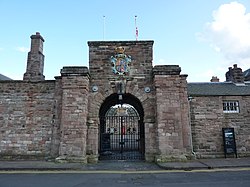| Berwick Barracks | |
|---|---|
| Berwick-upon-Tweed | |
 Berwick Barracks | |
| Site information | |
| Type | Barracks |
| Owner | English Heritage |
| Location | |
| Coordinates | 55°46′16″N02°00′04″W / 55.77111°N 2.00111°W |
| Site history | |
| Built | 1717–1721 |
| Built for | War Office |
| In use | 1721-Present |
Berwick Barracks, sometimes known as Ravensdowne Barracks, is a former military installation of the British Army in Berwick-upon-Tweed, England.
